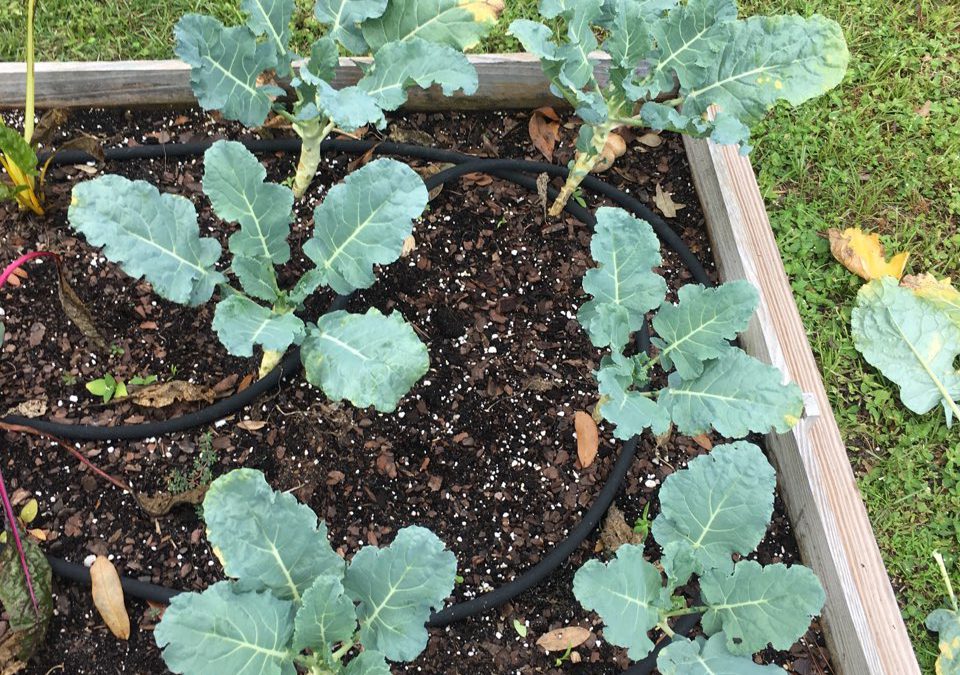
by Matthew Orwat | Oct 29, 2018
After hurricane Michael many fall vegetable gardens were uprooted, wind whipped or destroyed. All is not lost. The fall and winter vegetable season can recover before cold temperatures set in.
The first step is to assess the condition of the garden. Have plants been uprooted, blown over, or just superficially damaged? If they have been irreparably there is still time to set out transplants or direct seed the garden. Several radish cultivars are able to produce a crop in about 30 days from seed. Many different types of radishes, from Cherry Belle to Watermelon, are available which will offer quick results in this area. It is still prime time to set out Swiss chard plants and other Cole crops such as kale, collards, turnips and mustard. Broccoli could be grown throughout the winter if given frost protection from a low tunnel structure.
Strawberries may also be planted now, to establish themselves from spring production. Carrots are another good option for this time of year.
Please refer to the chart below to assess production timelines:
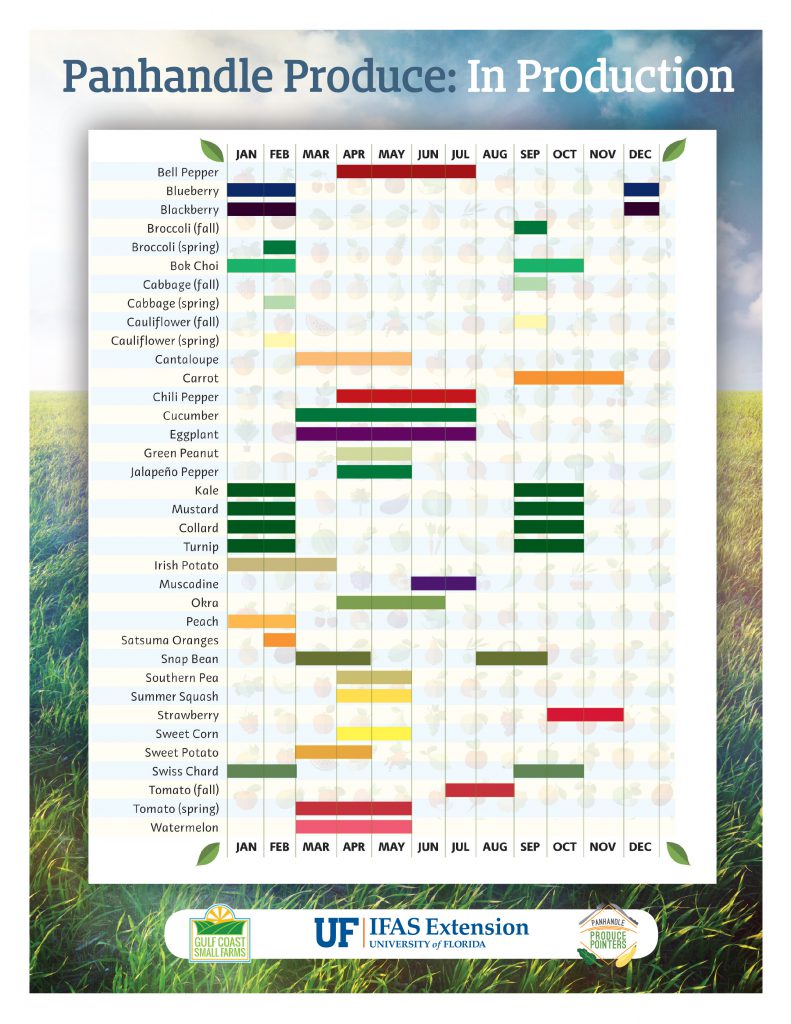

Broccoli neglected for 2 weeks following hurricane Michael. Fertilizer to follow. Image Credit Matthew Orwat, UF / IFAS
Sometimes plants have suffered wind damage. Remove damaged or dead leaves to discourage fungal disease and encourage new growth. Oftentimes excessive rain has washed fertilizer out of the garden bed and additional applications of nutrients may be needed.
The good news is this fall vegetable season is still salvageable. Even if you are busy with recovery efforts, plant a small container or a few square feet of vegetables for this fall and winter season. Your efforts will be rewarded with a table of fresh produce! For additional information about home vegetable production please refer to this UF / IFAS Publication: Florida Vegetable Gardening Guide .
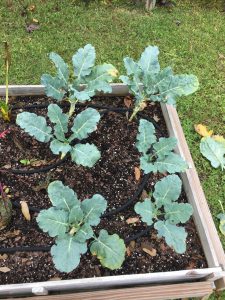
Broccoli trimmed after being neglected for 2 weeks following hurricane Michael. Fertilizer to follow. Image Credit Matthew Orwat, UF / IFAS
by Matt Lollar | Jun 21, 2018
Are you interested in growing squash in your garden? Do you know the difference between summer squash and winter squash? Check out this very informative instructional video on growing squash in your home garden by Walton County Agriculture Agent Evan Anderson.
[youtube https://www.youtube.com/watch?v=hlbJfV-0FuU&w=560&h=315]
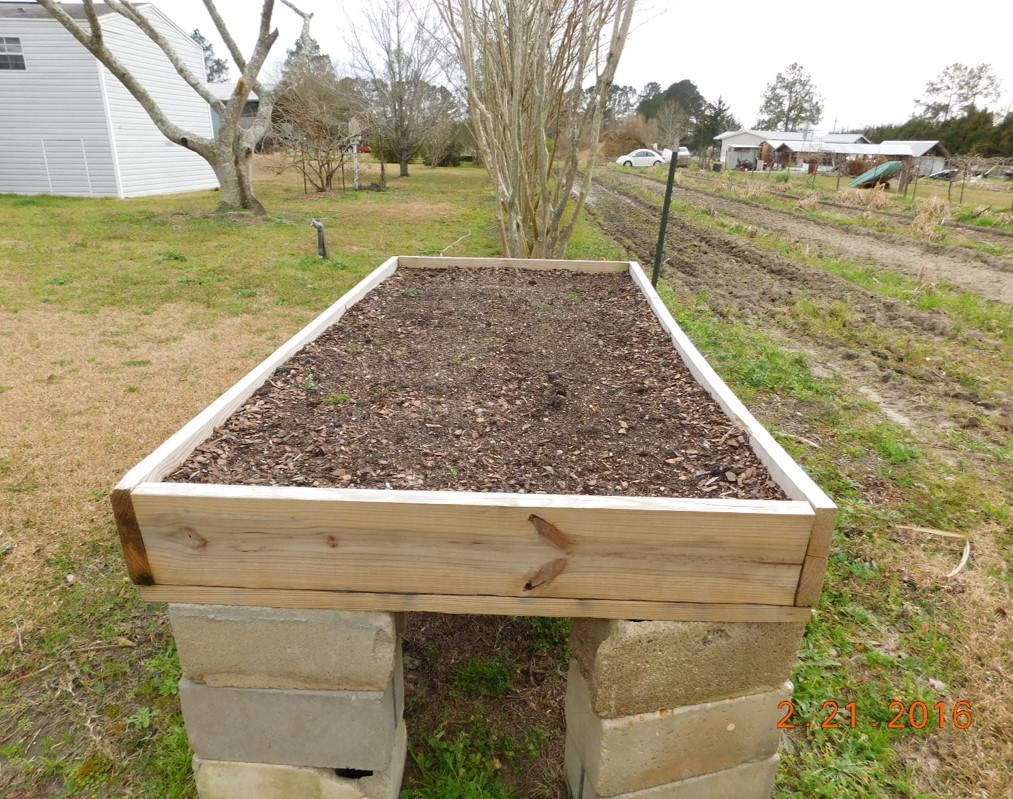
by Daniel J. Leonard | Oct 10, 2017
I had to do a hard thing last week. My battle-worn okra, eggplant and pepper plants that had produced so reliably since June and endured all the summertime challenges (heat, insects, disease, and a hurricane to name a few) were finally pulled out of my raised bed garden and discarded. A combination of lowered yields, increased insect pressure, and the fact that one can only eat so much okra in a calendar year sealed their fate.
However, before planting our cool-season veggie favorites, like those tender leafy greens and wonderfully crunchy carrots, there are a few things to do to get our raised beds in shape to give maximum yield performance and make growing a little easier.

Replenish the Soil
One of the main benefits of raised beds is the ability to grow in near-perfect soil conditions. If I was relegated to gardening in my yard’s less than ideal native sandy soil, I might have given up altogether by now and I suspect many of you would be in the same boat. Raised beds totally alleviate this problem and give gardeners the opportunity to grow in rich, fertile soil composed of your favorite homemade soil mixture (mine is two parts mushroom compost to one part aged pine bark) or commercial potting mix/compost. However, at the end of each growing season, you will notice you have a bit less soil in your beds than you did at the beginning. While frustrating, this is a natural process for soils rich in organic material – they naturally break down and decompose! So to give your veggies’ roots the maximum amount of growing space for the coming season, top off your beds with a quality soil/compost mix and till it in before sowing seed or setting out transplants.
Eliminate Competing Roots
If you have a mature tree anywhere near your raised bed garden, you are going to be in for a surprise when you till that new compost in! It turns out that tree roots like that rich, fertile raised bed soil just as much as vegetables do and will seek it out. It is not uncommon for mature trees to have root systems that stretch horizontally two to three times the height of the tree, meaning a 50’ oak tree could have roots growing well over a hundred feet away from its trunk! Therefore, unless you have a totally tree-free property, battling tree roots in your beds will be an ongoing issue. For instance, each fall, when I transition from warm season to cool season crops, I find that my neighbor’s Laurel Oak has filled all three of my raised beds full of feeder roots glad to be free of the infertile sand. This is a problem because those roots suck up vital water and nutrients meant for my vegetable crops, robbing them of reaching their full potential. It is good practice to thoroughly till your beds’ soil and remove as many of the competing roots as you can. Doing so will give your new plants a head start on becoming established before the competition returns.
Depleted soil and competition from tree roots are two of the biggest threats to your raised bed’s performance. By planning ahead and accounting for both of these things prior to planting your fall garden, you will be more likely to reap a larger yields when harvest time comes! For more information on raised bed vegetable gardening and other horticultural questions, contact your local UF/IFAS Extension Office. Happy fall gardening!
by Matt Lollar | Apr 13, 2017
Most of you plant a spring vegetable garden with a number of different vegetable types. However, you may not realize that you are improving the health of your soil and your crops by planting a diverse garden. Intercropping is a gardening practice of growing different crops in the same field. When planting a mixture of crops in the same field year after year, it is important to rotate the location of each type of vegetable. This is a practice known as crop rotation. Intercropping and crop rotation will help reduce insect pest populations, increase beneficial insect populations, and reduce weed populations.
Crop Diversity
Growing plants in your garden that pest insects don’t like to eat makes the pests work harder to find what they do like to eat. Studies have found reduced whitefly numbers on squash plantings mixed with a crop of buckwheat when compared to squash planted alone. Another crop mixture that may be unintentional, but may work in your favor is a row of crapemyrtles along the edge of your garden. Crapemyrtles will attract the crapemyrtle aphid which will attract predatory insects. When the predatory insects run out of crapemyrtle aphids to eat, they will move to your garden and begin to hunt pest insects on your vegetable crop.
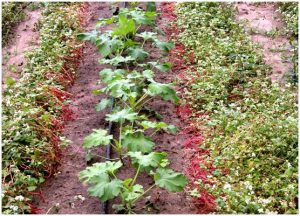
Squash with living mulch of buckwheat. Photo Credit: Oscar Liburd, UF/IFAS Extension
Trap Cropping
A trap crop is a plant that attracts a pest insect away from your food crops. Trap crops work best when planted at the edge of your garden, along a fence row, or in movable containers. A bare space, let’s say 5 feet or so, should be kept between your trap crop and your garden. This will help keep the pests from moving on to your vegetables. When you find a good population of pests on your trap crop then it is time to spray them with insecticide or cut the crop down and remove the debris to a location far from your garden. If your trap crops are planted in containers, then it makes them that much easier to remove from near the garden area.
Cover Crops and Green Manure
Soil organic matter can be increased by the use of green manure and cover crops. Cover crops are generally planted during the off-season, but they can be planted in between vegetable rows and tilled in at a designated time as a green manure. Both cover crops and green manure improve the production of your garden by:
- Suppressing weeds by competing for water, light, and nutrients;
- Holding the soil in place and preventing erosion;
- Scavenging for nutrients that can be utilized in future crops;
- Reducing nematode populations;
- Providing a habitat for beneficial insects.
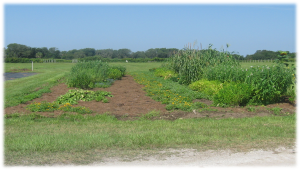
A mixed plot of cover crops and trap crops. Photo Credit: UF/IFAS Extension
A number of different crops can serve as cover crops or green manure crops. Most are legumes (bean family) or grasses. A few that you might like to give a try are:
- Cowpeas
- Sunn hemp
- Sorghum-sudangrass
- Winter rye
More detailed information on cover crops and green manure can be found at this link: http://edis.ifas.ufl.edu/aa217.
by Carrie Stevenson | Apr 7, 2017
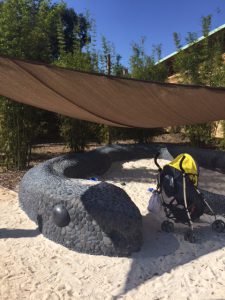
This sandbox area at Bok Tower Gardens is bordered by a stone “snake” and covered for shade, making it a real draw for small children and their parents. Photo credit: Carrie Stevenson, UF IFAS Extension
I recently had the pleasure of visiting Bok Tower Gardens in Lake Wales, Florida and experienced one of their newest additions, a children’s garden. As much a playground as a place for growing plants, it was full of whimsical energy and invitations to explore. The entire area encouraged children to reach beyond their comfort zones and engage with nature, including an outdoor art space, a climbing area made of lean-to logs, and a covered sand “box” shaped like a snake.
In recent years, sociologists, educators, and health experts have bemoaned the loss of free outdoor play in the lives of children. Multiple factors, including the rise in electronic entertainment, more organized, practice-heavy youth sports, fears of crime/abduction or just lack of safe access to ride bikes or walk, have contributed to a drop in the frequency and length of time that kids spend outdoors playing on their own. Many readers can probably relate to my childhood. We would take off on bikes in the mornings during summer and not come back until we got hungry. We didn’t have cell phones or GPS, and we knew all of our neighbors so we had a place to go if we had a rare emergency. The results of fewer child-led outdoor explorations include increases in childhood obesity, fear of the outdoors, difficulty with balance, agility, and managing excess energy.
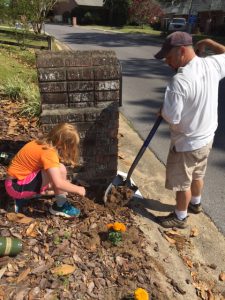
When children help plant a garden, they will be more interested in taking care of it–and tasting the fruits (or vegetables) of their labor! Photo credit: Carrie Stevenson, UF IFAS Extension
One way to encourage kids to get outside and explore is to plant something in your yard, school, or nearby park that can serve double-duty as a window to explore. Landscaping with young people in mind should include a variety of plants with interesting heights and textures, fruit-bearing shrubs or trees to engage the sense of taste, and lots of color. Logs to sit and climb on are perfect for developing balance and learning to take calculated risks. In addition, it is important to engage kids in the design and planting of the garden or landscape–if they have a hand in developing the area, they’ll be more invested in its success. In fact, research has consistently shown that children who help care for school gardens are more willing to try the food they’ve helped to grow. Beyond expanding a healthy palate, participation in school gardens can increase “soft” skills, such as the ability to work effectively in a team, better communication, and an increased appreciation for nature. Many kids also do better in science and gain a deeper understanding of proper nutrition after working with gardens.
If you are not a gardener or landscaper but interested in taking children outdoors where they can learn and become more comfortable, the US Forest Service has taken the research related to “nature-deficit disorder” so seriously that multiple “Children’s Forests” have been developed. While there are still very few in the southeastern US, there are dozens around the country. The stated goals for a Children’s Forest are: 1) Connect kids, families, and adults to healthy outdoor activities across all landscapes. 2) Create new education and career opportunities. 3) Foster an understanding of how our changing environment affects the world and how people can work together to embrace these changes. 4) Provide professional development opportunities for educators, with emphasis on conservation and the natural world. Local state and national parks often provide excellent programs for families as well, such as the National Park System’s Junior Ranger Program.
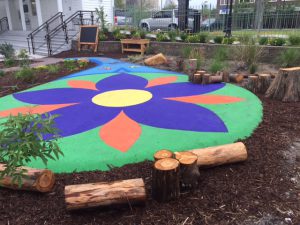
The landscaping at this coffee shop uses color, log seating/climbing, and a variety of interesting plants to attract children to engage with the outdoors.
A program in Gainesville called “Kids in the Woods” has recognized the lack of youth engagement in the outdoors and created field trips and curriculum for students designed to help make sure they are comfortable in the great outdoors. No matter how you engage the youth in your life with nature, it is important that they get outside, get dirty, and go beyond their comfort zone. Their health, academic success, and even motor skills needed for sports and daily life will reap the benefits!










